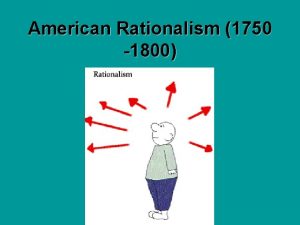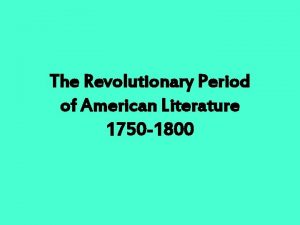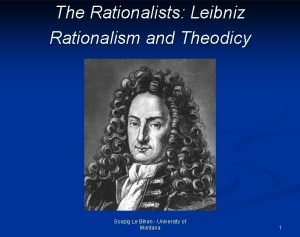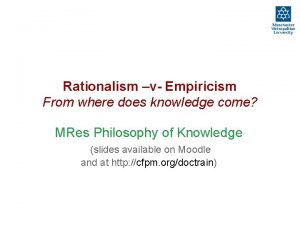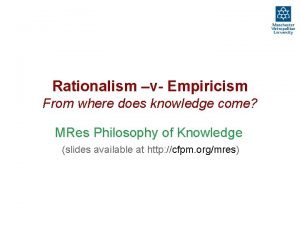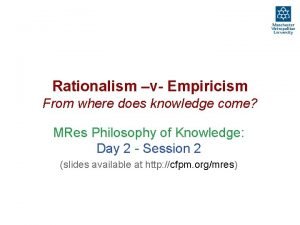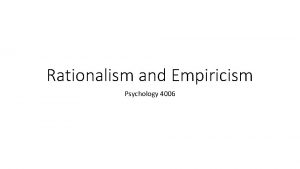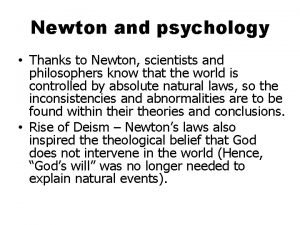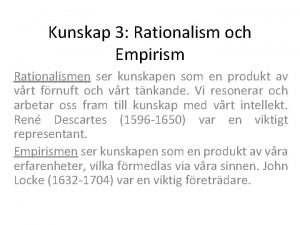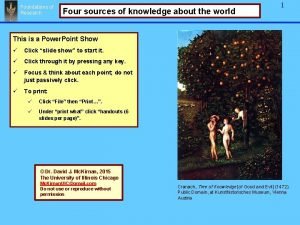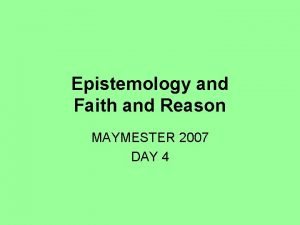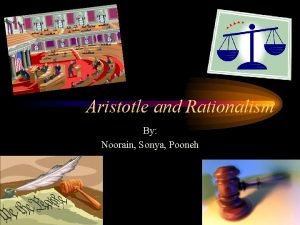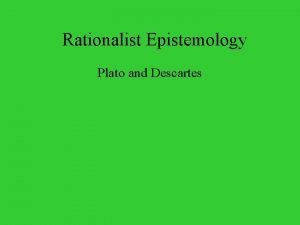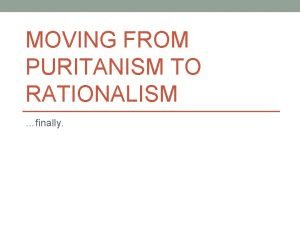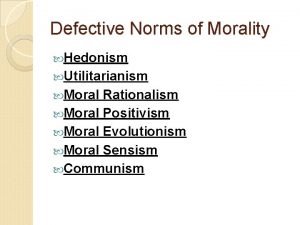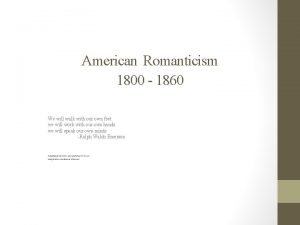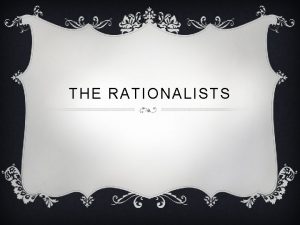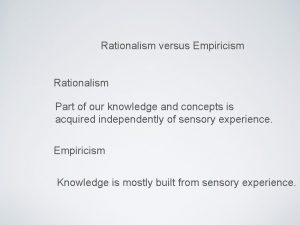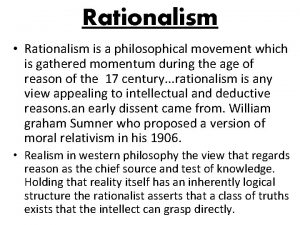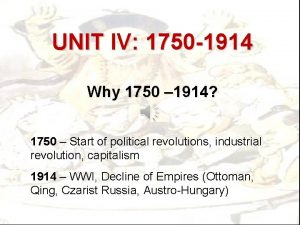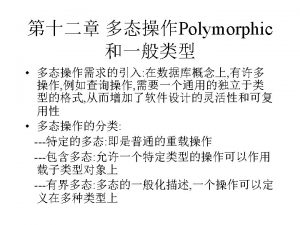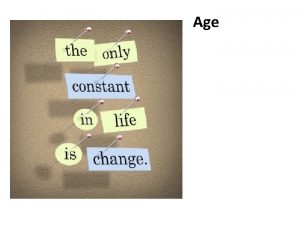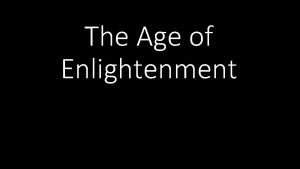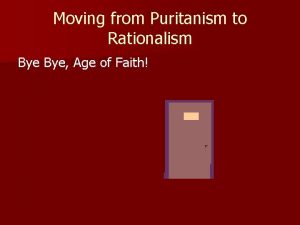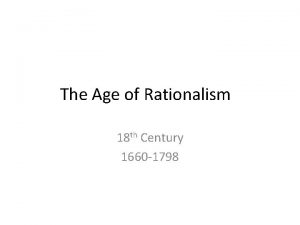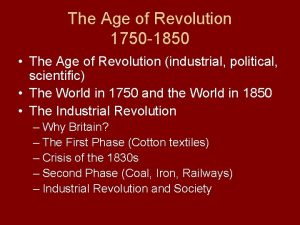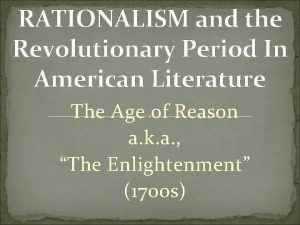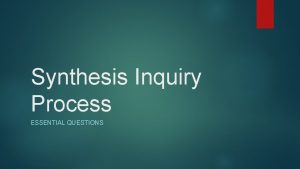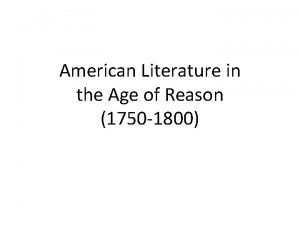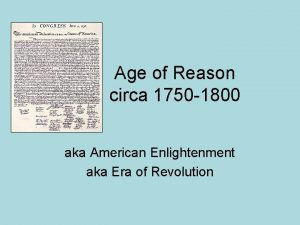ESSENTIAL QUESTIONS THE AGE OF AMERICAN RATIONALISM 1750





















- Slides: 21

ESSENTIAL QUESTIONS • • •

THE AGE OF AMERICAN RATIONALISM (1750 -1800)

REASON and LOGIC become more emphasized and valued than FAITH and RELIGION. RATIONALISM … • • • a. k. a the AGE of REASON OR ENLIGHTENMENT Rooted in belief that human beings can arrive at truth by using reason Do not have to rely on the authority of the past, on religious faith, or intuition. God’s gift to man = faculties to apply reason (ability to think in an ordered, logical manner) Enabled people to discover both scientific and spiritual truth. Reaction to British Imperialism and the crowns treatment of the Colonies. "I believe so that I might understand. ” is replaced by "I think, therefore I am. ”

RATIONALISM LITERATURE • Mostly devoted to politics, philosophy, ethics, and science • Persuasive essays and pamphlets • Songs • Speeches • Documents such as The Declaration of Independence based its arguments on rationalist assumptions about the relations between people, God, and natural law.

REASON THRIVED ON… • Freedom of speech • Freedom from arbitrary rules • Freedom to question existing laws and institutions • The Age of Reason in the United States differed from previous Rationalism movements in Europe namely because American citizens could test new ideas as they created a new society.

DELIVERING A SOUND AGRUMENT • Rhetoric The Art of Writing and Speaking • Rhetorical Devices Techniques that a writer or speaker uses to persuade a listening audience

RHETORICAL APPEALS • Emotional Appeal (Pathos) • Logical Appeal & Reason (Logos) • Ethical Appeal (Ethos)

PATTERNS OF THINKING

B. Deductive Reasoning: The process of deriving a conclusion from known facts • General statements to a specific conclusion • Example : X. Violent television influences some children in negative ways. (major premise) Y. Some children are violent. (minor premise) = Z. Some children are violent due to violent television. (conclusion) • A. Inductive Reasoning Moves from a set of specific examples to general statement • The speaker makes an inductive leap from evidence to a generalization • Example: 1) the students were well behaved, 2) the games were hilarious, 3) performances were entertaining = The pep assembly was a success. •

FAULTY REASONING • Oversimplification is a drastically simple solution to what is clearly a complex problem: “The U. S. has a problem with illegal immigration, so lets kick out the twelve million illegals that live in our country. ” • Hasty generalization is based on too little evidence or evidence that is not representative: “All illegals are sponging off the U. S. government. ” • Faulty temporal sequence is applying cause and effect erroneously: “Crime has increased in the U. S. , so illegal immigrants are causing the crime. ”

FAULTY REASONING • False analogy is making a misleading analogy between unconnected ideas: “If we can clone animals, then we should be able to find a cure for cancer. ” • Either/or thinking is seeing only two alternatives: “You are either an environmentalist or a polluter. ” • Non-sequitur is a conclusion that is clearly not related to the established premise or evidence (does not follow logically): “He sounds very sincere. He must know what he’s talking about. ”

For example, if you were to argue for stricter enforcement of a leash law and waste pickup ordinance for dog owners in your town, you might write the following: Logic • Dogs allowed to run free can be a menace to joggers and local wildlife. Logic • Dog waste poses a health risk, particularly in areas where children play. Emotion • How would you feel if you hit an unleashed dog with your car? Counterargument (Concession) • Turn against: Dogs need fresh air and exercise, too. • Turn back: Although, it must be handled in a manner that is safe for all.

Choose one of the following topics RAISING THE MINIMUM WAGE THE DEATH PENALTY FREE COLLEGE FIVE-YEAR HIGH SCHOOL STANDARDIZED TESTING

ACTIVITY: FORM A SOUND ARGUMENT 1. Choose one of the following controversial subjects and write a claim/argument for or against it. 2. Write three sentences that summarize three important points, two based on logic and one based on emotional appeal. 3. The Turn Against: Write one sentence that acknowledges the opposing point of view or Counterargument to your position (a. k. a. “Concession to the opposition. Start the sentence with “Some will say. ” 4. The Turn Back: Write one sentence that will counter and undo the point made for the other side.

“SPEECH TO THE VIRGINIA CONVENTION” Patrick Henry 1775

• "Concession to the Opposition“: Why make a concession and give your opposition power? • Where does Patrick Henry use emotional and logical appeal in his speech? • What is the advantage to using both types of appeals? • What literary devices can be found in his speech? Why does he use them? • The last paragraph's uses repetition. What is the purpose for this rhetorical device?

“THE DECLARATION OF INDEPENDENCE” Thomas Jefferson 1776

QUESTION #1 The Declaration of Independence is a deductive argument; therefore, it can be presented in the form of a syllogism. What are the major premise, the minor premise, and the conclusion of Jefferson's argument? A. What is the major premise? B. What is the minor premise? C. What is the conclusion?

QUESTION #3 Why would Jefferson need to provide evidence for his argument? So what evidence does Jefferson offer in support of his major premise?

QUESTION #4 Although the basic structure of the Declaration reflects sound deductive reasoning, Jefferson's language, particularly when he lists the charges against the king, tends to be emotionally charged. What is his tone? One word to describe.

RHETORICAL DEVICE • Parallelism or Parallel Structure: Rhetorical Device commonly used in speeches and persuasive writing for dramatic effect. • Why is parallelism used? • • Drives home the point • Creates rhythm or cadence for the listener to follow. • Contributes to and builds the emotional tone. Where does Thomas Jefferson use parallelism for dramatic effect in his speech?
 Iron age bronze age stone age timeline
Iron age bronze age stone age timeline Iron age bronze age stone age timeline
Iron age bronze age stone age timeline Rationalism in literature
Rationalism in literature Revolutionary period in american literature
Revolutionary period in american literature Plamatic acid
Plamatic acid Leibniz racionalismo
Leibniz racionalismo Empirism och rationalism
Empirism och rationalism Where does knowledge come from
Where does knowledge come from Rationalism v empiricism
Rationalism v empiricism Rationalism psychology
Rationalism psychology Rationalism psychology
Rationalism psychology Spinoza rationalism
Spinoza rationalism John locke empirism
John locke empirism Shutterstockü
Shutterstockü Rationalist
Rationalist Rationalism aristotle
Rationalism aristotle Rationalism literature
Rationalism literature Plato rationalist
Plato rationalist Rationalism vs puritanism
Rationalism vs puritanism Defective norms of morality essay
Defective norms of morality essay Values feeling and intuition over reason
Values feeling and intuition over reason Rationalism is the belief that
Rationalism is the belief that


